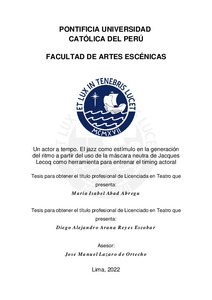| dc.contributor.advisor | Lazaro de Ortecho, Jose Manuel | |
| dc.contributor.author | Abad Abregu, Maria Isabel | |
| dc.contributor.author | Arana Reyes Escobar, Diego Alejandro | |
| dc.date.accessioned | 2023-06-22T17:01:20Z | |
| dc.date.available | 2023-06-22T17:01:20Z | |
| dc.date.created | 2022 | |
| dc.date.issued | 2023-06-22 | |
| dc.identifier.uri | http://hdl.handle.net/20.500.12404/25252 | |
| dc.description.abstract | El término “timing” es comúnmente utilizado en la formación actoral y el trabajo escénico;
no obstante, su concepto no ha sido sistematizado bajo la denominación mencionada. Por
ende, no se explica a los actores y actrices cómo llegar a obtenerlo. Por lo tanto, con esta
investigación, se propone un concepto de timing y se busca sistematizar un entrenamiento del
mismo, mediante el género musical jazz y lo propuesto por Jacques Lecoq en la máscara
neutra. De esta manera, será necesario analizar el jazz como estímulo para el principio de
ritmo trabajado en el uso de la máscara neutra como herramienta de entrenamiento para el
timing actoral. Además, se contará con otras investigaciones que aportan al ámbito musical y
al actoral. Entre las fuentes principales de este trabajo, resaltan Jacques Lecoq, quien expone
su pedagogía con la máscara neutra; Henkjan Honing, que profundiza en el timing desde el
campo de la música; y José Martínez, quien explica el jazz y sus principios swing y free
playing.
Para comprobar la hipótesis de esta investigación, se realizó un laboratorio presencial. En
este, se utilizaron ejercicios de la pedagogía de Lecoq con la máscara neutra, y se
incorporaron diversas piezas de los subgéneros del jazz a modo de estímulo sonoro. Como
resultado, se obtuvo una evolución del sentido del timing en cada participante. Esto fue
plasmado en el proceso del laboratorio y en la muestra final del mismo. Así, comprobamos
que el free playing del jazz estimula el principio de ritmo trabajado por Lecoq. Pues,
desarrolla una asociación entre referencias musicales y expresiones corporales, potenciando
la creatividad activa de los y las participantes. De esta manera, se genera un entrenamiento en
el cual el sentido musical y rítmico le brinda al intérprete un swing al accionar, y, por ende,
un mejor manejo del timing. | es_ES |
| dc.description.abstract | The term “timing” is commonly used in acting training and in stage work; yet, its meaning
hasn’t been systematized based on the mentioned denomination. Thus, actors and actresses
get no explanation about how to achieve it. Therefore, with this research, we propose a
concept of timing and we seek to systematize a training for it, through the musical genre of
jazz and what Jacques Lecoq proposed with the neutral mask. So, it will be necessary to
analyze jazz as a stimulus for the rhythmic principle developed in the use of the neutral mask
as a training tool for acting timing. In addition, there will be other researches that contribute
to the musical and acting field. Among the main sources of this work, Jacques Lecoq stands
out, exposing his pedagogy with the neutral mask; Henkjan Honing, delves into timing from
the music field; and José Martínez, explains jazz and its principles: swing and free playing.
To test the hypothesis of this research, a face-to-face laboratory was carried out. During this,
exercises from Lecoq’s pedagogy with the neutral mask were used, and various pieces from
the jazz subgenres were incorporated as sound stimulus. As a result, an evolution of the sense
of timing was obtained by each participant. This was reflected in the laboratory process and
in the closure session. Thus, we verify that the free playing from jazz stimulates the principle
of rhythm developed by Lecoq. Because, it develops an association between musical
references and body expressions, enhancing the active creativity of the participants. So, a
training is generated in which the musical and rhythmic sense gives the performer a swing
when acting, and, therefore, a better timing. | es_ES |
| dc.language.iso | spa | es_ES |
| dc.publisher | Pontificia Universidad Católica del Perú | es_ES |
| dc.rights | info:eu-repo/semantics/openAccess | es_ES |
| dc.rights | Atribución-CompartirIgual 2.5 Perú | * |
| dc.rights.uri | http://creativecommons.org/licenses/by-sa/2.5/pe/ | * |
| dc.subject | Lecoq, Jacques--Crítica e interpretación | es_ES |
| dc.subject | Música en el arte--Perú--Lima | es_ES |
| dc.subject | Actuación--Ritmo | es_ES |
| dc.subject | Jazz | es_ES |
| dc.title | Un actor a tempo. El jazz como estímulo en la generación del ritmo a partir del uso de la máscara neutra de Jacques Lecoq como herramienta para entrenar el timing actoral | es_ES |
| dc.type | info:eu-repo/semantics/bachelorThesis | es_ES |
| thesis.degree.name | Licenciado en Teatro | es_ES |
| thesis.degree.level | Título Profesional | es_ES |
| thesis.degree.grantor | Pontificia Universidad Católica del Perú. Facultad de Artes Escénicas | es_ES |
| thesis.degree.discipline | Teatro | es_ES |
| renati.advisor.dni | 08860953 | |
| renati.advisor.orcid | https://orcid.org/0000-0002-8320-5540 | es_ES |
| renati.author.dni | 76298771 | |
| renati.author.dni | 73663324 | |
| renati.discipline | 215586 | es_ES |
| renati.juror | Chiarella Viale, Mateo | es_ES |
| renati.juror | Lazaro De Ortecho Ramirez, Jose Manuel | es_ES |
| renati.juror | Guerra Morales, Alejandra | es_ES |
| renati.level | https://purl.org/pe-repo/renati/level#tituloProfesional | es_ES |
| renati.type | https://purl.org/pe-repo/renati/type#tesis | es_ES |
| dc.publisher.country | PE | es_ES |
| dc.subject.ocde | https://purl.org/pe-repo/ocde/ford#6.04.04 | es_ES |







